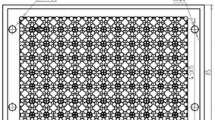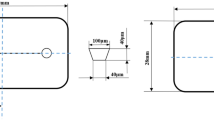Abstract
Microchannel is a fundamental structure in various microfluidic systems. Precise reproduction of microchannel is required to achieve reliable efficiency of microfluidic systems. In this paper, we present the parametric sensitivity study of the replication of a cross microchannel by injection molding with a nickel mold insert which was fabricated by the UV-LIGA process. The effects of processing parameters of the injection molding on the transcription properties of cross-sectional geometry of the microchannel were quantitatively characterized by means of design of experiments based on the Taguchi method by varying mold temperature, melt temperature, injection speed and packing pressure. To quantitatively characterize the transcription properties, a measure, relative error between the size of mold insert and that of injection molded microchannel was newly suggested. From the sensitivity analysis of the experimental results based on the relative error, it was identified that mold temperature is the most sensitive processing parameter in this study. And also, the important processing parameter was found to become mold temperature, injection speed, packing pressure and melt temperature in the order of sensitivity. The optimal and worst processing conditions were also found in this study.








Similar content being viewed by others
References
Ahn CH, Choi JW, Beaucage G, Nevin JH, Lee JB, Puntambekar A, Lee JY (2004) Disposable smart lab on a chip for point-of-care clinical diagnostics. Proc IEEE 92:154–173
Becker H, Gärtner C (2000) Polymer microfabrication methods for microfluidic analytical applications. Electrophoresis 21:12–26
Ceriotti L, Weible K, de Rooij NF, Verpoorte E (2003) Rectangular channels for lab-on-a-chip applications. Microelectron Eng 67–68:865–871
Duffy DC, McDonald JC, Schueller OJA, Whitesides GM (1998) Rapid prototy** of microfluidic systems in poly(dimethylsiloxane). Anal Chem 70:4974–4984
Dutta D, Ramachandran A, Leighton Jr DT (2006) Effect of channel geometry on solute dispersion in pressure-driven microfluidic systems. Microfluid Nanofluid 2:275–290
Jacobson SC, Ramsey JM (1997) Electrokinetic focusing in microfabricated channel structures. Anal Chem 69:3212–3217
Kim DS, Lee SH, Ahn CH, Lee JY, Kwon TH (2006a) Disposable integrated microfluidic biochip for blood ty** by plastic microinjection moulding. Lab Chip 6:794–802
Kim DS, Lee HS, Lee BK, Yang SS, Lee SS, Kwon TH (2006b) Replications and analysis of microlens array fabricated by a modified LIGA process. Polym Eng Sci 46:416–425
Lee GB, Chang CC, Huang SB, Yang RJ (2006) The hydrodynamic focusing effect inside rectangular microchannels. J Micromech Microeng 16:1024–1032
Manz A, Grabber N, Widmer HM (1990) Miniaturized total chemical analysis systems: a novel concept for chemical sensing. Sensor Actuat B1:244–248
Woolley AT, Mathies RA (1994) Ultra-high-speed DNA fragment separations using microfabricated capillary array electrophoresis chips. Proc Natl Acad Sci USA 91:11348–11352
**a Y, Whitesides GM (1998) Soft lithography. Angew Chem Int Ed 37:550–575
Xuan X, Li D (2005) Focused electrophoretic motion and selected electrokinetic dispensing of particles and cells in cross-microchannels. Electrophoresis 26:3552–2560
Xue Y, Yeung ES (1994) Characterization of band broadening in capillary electrophoresis due to nonuniform capillary geometries. Anal Chem 66:3575–3580
Acknowledgments
The authors would like to thank for financial support via the Production Technology Research Project of Korea Institute of Industrial Technology (KITECH).
Author information
Authors and Affiliations
Corresponding authors
Rights and permissions
About this article
Cite this article
Kim, D.S., Kim, J.S., Ko, Y.B. et al. Experimental characterization of transcription properties of microchannel geometry fabricated by injection molding based on Taguchi method. Microsyst Technol 14, 1581–1588 (2008). https://doi.org/10.1007/s00542-007-0553-4
Received:
Accepted:
Published:
Issue Date:
DOI: https://doi.org/10.1007/s00542-007-0553-4




